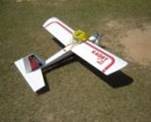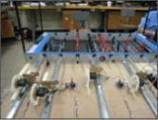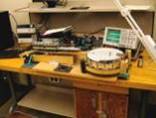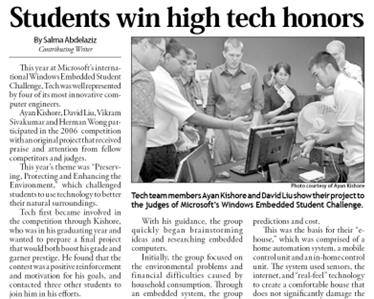The School of Electrical and Computer Engineering
James Hamblen - Professor
Dr. James O. Hamblen, a professor in the computer engineering area, joined the Georgia Tech Faculty in 1984 after graduating with his Ph.D. in electrical engineering from Georgia Tech. His other degrees include an M.S.E.E. from Purdue University and a B.E.E. from Georgia Tech.
Prior to returning to Georgia Tech to work on his Ph.D., he worked several years in industry. While working on his M.S.E.E. degree he was employed by Wescom Inc. in Chicago, Illinois where he worked on the design of a fault-tolerant multiprocessor PBX system. Subsequently, he worked as a systems analyst for Texas Instruments in Austin, Texas, and as a senior engineer for Martin Marietta Corporation in Denver, Colorado. At Texas Instruments, he was involved in the design of the TMS9900 microprocessor development system. The TMS9900 was one of the world’s first 16-bit microprocessors. At Martin Marietta, he was a senior engineer in the software research and development section where he worked on computer systems for satellites and spacecraft. In 1999, he was a visiting faculty member at Intel in Phoenix, AZ. He teaches courses in digital hardware, computer architecture, operating systems, and embedded systems design.
In 2004, by a vote of the senior class in electrical and computer engineering, Professor Hamblen was awarded the Eta Kappa Nu Outstanding Teacher Award. In 2006, Professor Hamblen received Georgia Tech’s campus wide Class of 1940 W. Roane Beard Outstanding Teacher Award. At Georgia Tech, Professor Hamblen has taught over six thousand students in his classes, and he has obtained several million dollars of equipment donations and grants from industry to help equip the computer engineering instructional laboratories. Professor Hamblen's current research interests include rapid prototyping with FPGAs, embedded systems, computer architecture, continuous system simulation, and SoPC design. He has had funded research projects and grants from NSF, the Ballistic Missile Defense Advanced Technology Center, IBM, Digital Equipment Corporation, the US Army, the US Air Force, Intel, Cypress Semiconductor, and Microsoft.
Instructional Materials for Students
(To avoid problems playing the movie, download file first)
- Student Design Project Web Pages
- Free Electronic version of Textbook (or in a DVD *.iso file format)
- ALTERA UP1 & UP2 FPGA Board Information and Demos
- ALTERA UP3 FPGA Board Information and Demos
- ALTERA DE2 FPGA Board Information and Demos

Judging the recent Imagine Cup Embedded Challenge Student Design Contest Finals at the Louvre, a year earlier in Seoul,

The embedded challenge student design contest awards ceremony at the Pyramids of Giza,

And more recently the embedded challenge student demo booth area at the Warsaw opera house.


Two of Georgia Tech’s Student Teams at the WESC Design Contest Finals in Seattle.

Recent Student mbed Projects from ECE 4180
Selected Publications
BOOKS
Introduction to Embedded Systems using Windows Embedded CE – Second Edition, J. Hamblen, Microsoft, June 2008. Also available in German, Chinese, Korean, and Japanese translations.
Rapid Prototyping of Digital Systems - SoPC Edition, J. Hamblen, T. Hall, and M. Furman, Springer, August 2007.
Introduction to Embedded Systems using Windows Embedded CE, J. Hamblen, Microsoft, June 2007.
“FPGAs for Rapid Prototyping,” J. Hamblen, a chapter in Digital Design and Fabrication, 35 pages, V. Oklobzija editor, CRC Press, November 2007.
Rapid Prototyping of Digital Systems - Quartus Edition, J. Hamblen, T. Hall, and M. Furman, Springer, August 2005.
Rapid Prototyping of Digital Systems - Second Edition, J. Hamblen and M. Furman, Kluwer Academic Publishers, August 2001.
“FPGAs for Rapid Prototyping,” J. Hamblen, a chapter in The Computer Engineering Handbook, 30 pages, V. Oklobzija editor, CRC Press, December 2001.
Rapid Prototyping of Digital Systems, J. Hamblen and M. Furman, Kluwer Academic Publishers, August 1999.
Introduction to Microprogramming, Text and Courseware, Hamblen, J. O. and Parker, A., ISBN 0-89512-203-0, Dallas: Texas Instruments, 1989.















SELECTED JOURNAL AND CONFERENCE PAPERS
J.O. Hamblen and G. M. E. Van Bekkum, Using a Web 2.0 Approach for Embedded Microcontroller Systems, Frontiers in Education: Computer Science & Computer Engineering, FECS 2011, pp. 277-281, Las Vegas, NV., July 2011.
J.O. Hamblen, Using a low-cost SoC Computer and a Commercial RTOS in an Embedded Systems Design Course, IEEE Transactions on Education, vol 51, no. 3, 356-363, August 2008.
J. O. Hamblen, An Undergraduate Embedded Systems Design Course Based on a Commercial Embedded Operating System, Workshop on Embedded Systems Education, October 4-5, 2007, Salzburg, Austria.
Scott, W.R., Hamblen, J. O., Martin, J, and Larson, G., Large Vibrometer Arrays for Seismic Landmine Detection, SPIE Proceedings of Detection and Remediation Technologies for Mines and Minelike Targets XI, vol. 6217, pp. 621712-1 621712-10, 2006 Orlando, Florida.
J. O. Hamblen, and T. Hall, Using System-on-a-Programmable Chip Technology to Design Embedded Systems, International Journal of Computers and Their Applications, vol 13, no.3, 142-152, September 2006.
T. S. Hall and J. O. Hamblen, System-on-a-Programmable-Chip Development Platforms in the Classroom, , IEEE Transactions on Education, pp. 502-507, vol. 47, no. 4, November 2004.
J. O. Hamblen and T. S. Hall, Engaging Undergraduate Students with Robotic Design Projects, Proceedings of the Second IEEE International Workshop on Electronic Design, Test and Applications, pp. 140-145, January 28-30, 2004, Perth, Australia.
Newman, K., Hamblen, J.0., and Hall, T., An Introductory Digital Design Course Using a Low-cost Autonomous Robot, IEEE Transactions on Education, pp.289-296, vol.45, no. 3, August 2002. Received the IEEE Education Society Best Transactions Paper Award in 2003.
J. Hamblen, Rapid Prototyping Using Field Programmable Logic Devices, IEEE Micro, pp.29-37, vol.20 no.3, May/June 2000.
J. Hamblen and G. Ruhl, Using the Altera UP 1 Board for Prototyping and VGA Video Display Generation, IEEE MSE 99, pp. 16-17, Washington D. C., July 1999.
J. Hamblen, H. Owen and S. Yallamanchili, An Undergraduate Computer Engineering Rapid Systems Prototyping Laboratory, IEEE Transactions on Education, February 1999.
J. Hamblen, Using Large CPLDs and FPGAs for Prototyping and VGA Video Display Generation in Computer Architecture Design Laboratories (PDF), WCAE-4, Las Vegas, NV, pp. 1.A.2-1.A.6, January 1998. Reprinted in the IEEE Computer Society Technical Committee on Computer Architecture Newsletter, July 1999, pp. 12-14.
J. Hamblen, A VHDL Synthesis Model of the MIPS Processor for use in Computer Architecture Laboratories, IEEE Transactions on Education, November 1997.
J. Hamblen, Using Synthesis, Simulation, and Hardware Emulation to Prototype a Pipelined RISC Computer System, MSE 97, Session IV-6, pp. 131-132, Washington D. C., July 1997. MSE 97 Proceedings (PDF)
J. Hamblen, H. Owen and S. Yallamanchili, Introduction of Rapid Systems Prototyping into Undergraduate Computer Engineering Curricula, Frontiers in Education 95, pp. 2c3.5-2c3.8, Atlanta, GA, November 1995.
J. Hamblen, H. Owen, S. Yallamanchili and B. Dao, Using Rapid Prototyping in Computer Architecture Design Laboratories, WCAE 95, , San Jose, CA, February 1996. Proceedings also appear in IEEE Technical Committee on Computer Architecture Newsletter, June 1996.
James 0. Hamblen, Using VHDL Based Modeling, Synthesis, and Simulation in an Introductory Computer Architecture Laboratory, International Journal on Electrical Engineering Education, pp. 251-260, July 1996.
Hamblen, J.O. and Parker, A. ,"Optimal value for the Newton-Raphson Division Algorithm," Information Processing Letters, vol. 42, pp. 141-144, May 1992.
Braham, R. and Hamblen, J.O., "Design of a Neural Network with a Biologically Motivated Architecture," IEEE Transactions on Neural Networks, vol. 1, no. 3, pp. 251-263, September 1990.
Parker, A. and Hamblen, J. O., "Optimality Equations for an All-Pole Model with Multiple Impulse Excitation," Signal Processing, vol. 17, no. 2, pp.119-128, June 1989.
Hamblen, J.O. , "Parallel Continuous System Simulation using the Transputer," Simulation vol. 49, no. 6, pp. 249-253, December 1987. (computer graphics featured on cover) 119-128, June 1989.
Hamblen, J.O. and Alford, C.O., "A Parallel Computer Architecture for Continuous Simulation," IEEE Transactions on Aerospace and Electronics, vol. 24, no. 6, pp. 719-725, November 1988.
Hamblen, J.O. and Parker, A., "An Updated PC Based Assembly Language Programming Laboratory," IEEE Transactions on Education, vol. 31 no. 4, pp. 241-245, November 1988.
Parker, A. and Hamblen, J.O., "A Fast Technique for the Evaluation of Unary Floating Point Functions," Transactions on Simulation, vol. 5 no. 2, pp. 99-108, April 1988.
Braham, R. and Hamblen, J. O., "On the Behavior of Some Associative Neural Networks," Biological Cybernetics, vol. 60, pp. 145-151, 1988.
Braham, R. and Hamblen, J.O., "Simulation of Integrated Circuits," Transactions on Simulation, vol. 5, no. 4, pp. 243-263, October 1988.
PHOTOGRAPHS AND MOVIES















The 40 minute short film Embedded System Design Projects (*.wmv) contains entertaining short video clips of undergraduate student design project demos at Georgia Tech that were directed by Professor Hamblen. For more reliable video play, download the 400M movie file first to a local disk. Several of the projects in the video were finalists in national design contests and have been covered in other media.
Here are some short You Tube video clips of some of the student design projects that were covered in the media. An assortment of articles on student projects from ECE 4180 & 4007 can be seen below.






























Several hundred ultraviolet light fluorescent mineral photos by Professor Hamblen also appear in The Photo Atlas of Minerals produced by the Los Angeles County Museum of Natural History, commercial ads for ultraviolet products, and an online database of fluorescent minerals.












.
SELECTED ENGINEERING RESEARCH AND DEVELOPMENT PROJECTS

At Wescom in Chicago, Illinois assembly language programming and an early hardware debug monitor program for the 580 digital PBX. It was the first PBX system to use distributed microprocessors (six 8-bit 8080s) and it had a number of other innovative telephony features. Over 16 patents were issued to Wescom based on the 580 and several more followed after they were purchased by Rockwell. Unfortunately, a photo of that exact PBX model is not available and this is a generic PBX photo.

 At Texas Instruments in Austin, Texas, software for the in-circuit emulator and software development system for the TI TMS9900, one of the first single chip 16-bit Microprocessors.Those are gold plated pins.
At Texas Instruments in Austin, Texas, software for the in-circuit emulator and software development system for the TI TMS9900, one of the first single chip 16-bit Microprocessors.Those are gold plated pins.
At Martin Marietta in Denver, Colorado, software for the first prototype of a computerized intelligent battery and solar power management system used in several US spy satellites. It replaced the non eco-friendly plutonium thermoelectric nuclearreactors used in the earlier versions. The NiCAD batteries alone cost over $250,000 per satellite. The satellite is the payload in this Titan rocket being launched atVandenberg AFB. They also made the Titan rockets and the Viking lander in Denver. Photos of the satellites are still classified, but they look a bit like the Hubble space telescope seen here.



The Microbot Z80-based micromouse in the first IEEE Spectrum Micromouse race held at the Disneyland Hotel. One of only two robots to find the exit to the maze. This recent maze is similar to the early ones. Video from the race appeared on TV and photos of the microrobot appeared in several magazine articles. An early Altair 8800 built from a kit was used for software development and some of the parts.

 At Georgia Tech for Whirlpool, an 8048-based prototype of small control computer for a Whirlpool washing machine with one of the first automatic water temperature control systems. Using only a low-cost temperature sensor in the water inlet, it achieved temperature control within a few degrees by deciding exactly when to turn on and then turn off the hot and cold water values as the tub fills. Any additional cycling of values had to be avoided since it would reduce the lifetime of the values.
At Georgia Tech for Whirlpool, an 8048-based prototype of small control computer for a Whirlpool washing machine with one of the first automatic water temperature control systems. Using only a low-cost temperature sensor in the water inlet, it achieved temperature control within a few degrees by deciding exactly when to turn on and then turn off the hot and cold water values as the tub fills. Any additional cycling of values had to be avoided since it would reduce the lifetime of the values.

PhD thesis project, SPOCK II, a high-speed parallel computer system designed to solve systems of complexdifferential equations in real time. Faster than any other systems available at that time, it led to a five year $21,000,000 SDI research contract at Georgia Tech and was featured once in an SDI news story on the CBS evening news. After finishing the prototype seen here for the thesis project, it took almost three years to get security clearances to publish any papers related to it.

At Georgia Tech for Texas Instruments, microcode for the first 32-bit instruction set reference design for the TI 74ACT8818/8832/8847 VLSI processor chipset. A PC-based development microprogramming laboratory development and debugging environment with a microcode meta-assembler, and laboratory textbook were also developed. This TI chipset was used in some of the later implementations of the PDP-11 minicomputer and several DEC and Sun workstations. The TI 8800 SDB PC-based microprogrammed development board with writable control store is pictured here. It was used in ECE student labs for several years and the student developed meta-assembler was used in a December 2009 FPGA microprogramming project in Circuit Cellar magazine. The interesting Pulitzer Prize winning book,The Soul of a New Machine, tells the story of the design of a microcoded computer by engineers at Data General. One of the characters in the book was a Georgia Tech student and there are some other connections.

The initial VHDL synthesis model for an FPGA chip design that is now used in an Air Force Fighter’s missile fire control system. Over a year of hardware testing was done by GTRI at Warner Robins AFB for flight qualification.

At Intel in Phoenix, Arizona a Celeron-based hardware reference computer design for embedded system designers and a Windows CE OS port.



FPGA IP cores and laboratory projects developed for four editions the textbook, Rapid Prototyping of Digital Systems. VHDL-based IP cores include a simple computer design, a VGA video controller, a character generation ROM, graphics memory, an LCD controller, a PWM controller, a PS/2 mouse and keyboard interface, a small robot controller, and a MIPS processor core.

A recent prototype of an acoustic/seismic mine detection system using a large array of low-cost MEMs accelerometers controlled by a Xilinx FPGA with twoPowerPC processors (SoPC). Plastic mines cannot be detected using the traditional RF-based mine detectors that only detect metallic objects.







Embedded system design laboratory projects developed for Microsoft. Windows Embedded CE OS-based projects for a low power X86 target systeminclude USB-based analog and digital I/O for various sensors and motors, an LCD text display, a web camera, speech synthesis, touch screen, robots, GPS, and a cell phone modem.
Instructional Materials from Earlier Quarter-based Courses
Full die photograph of the MIPS R2000 RISC Microprocessor.
The 1986 MIPS R2000 with five pipeline stages and 450,000 transistors was the world’s first commercial RISC microprocessor.
Photograph ©1995-2004 courtesy of Michael Davidson, Florida State University, http://micro.magnet.fsu.edu/chipshots.


















沒有留言:
張貼留言